Attached files
| file | filename |
|---|---|
| EX-99.2 - EX-99.2 - Larimar Therapeutics, Inc. | d504709dex992.htm |
| 8-K - 8-K - Larimar Therapeutics, Inc. | d504709d8k.htm |
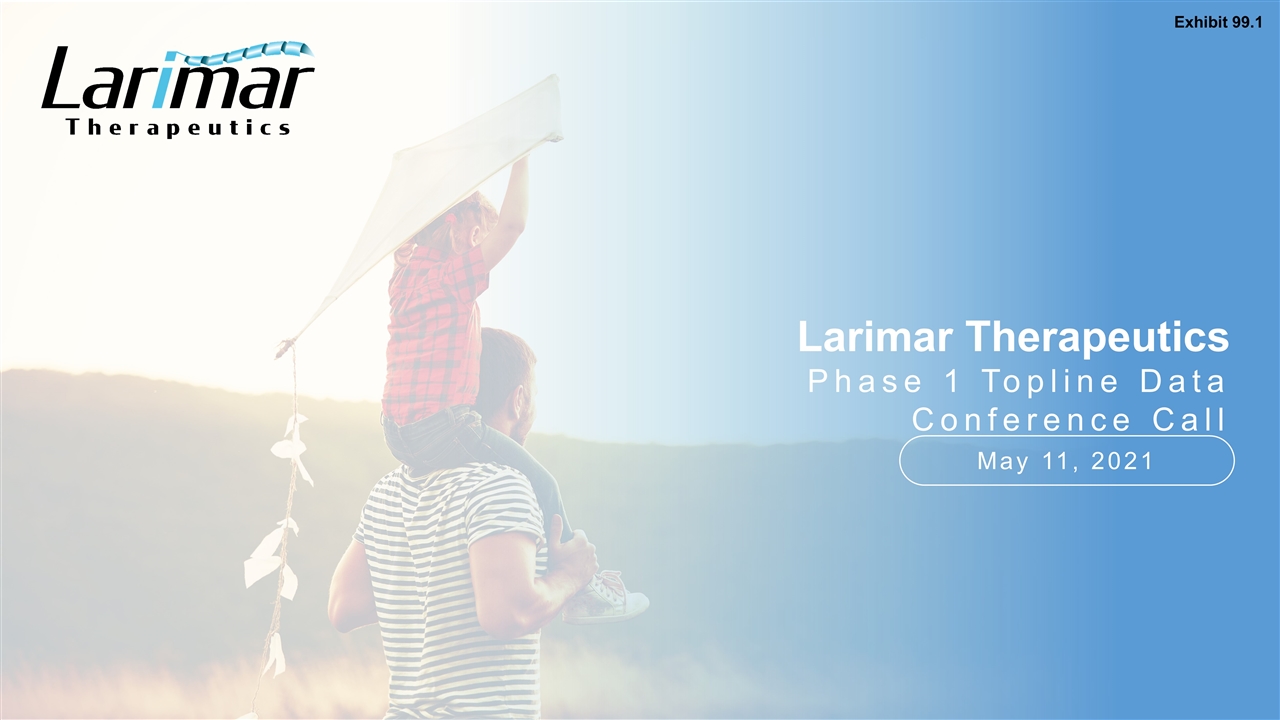
May 11, 2021 Larimar Therapeutics Phase 1 Topline Data Conference Call Exhibit 99.1
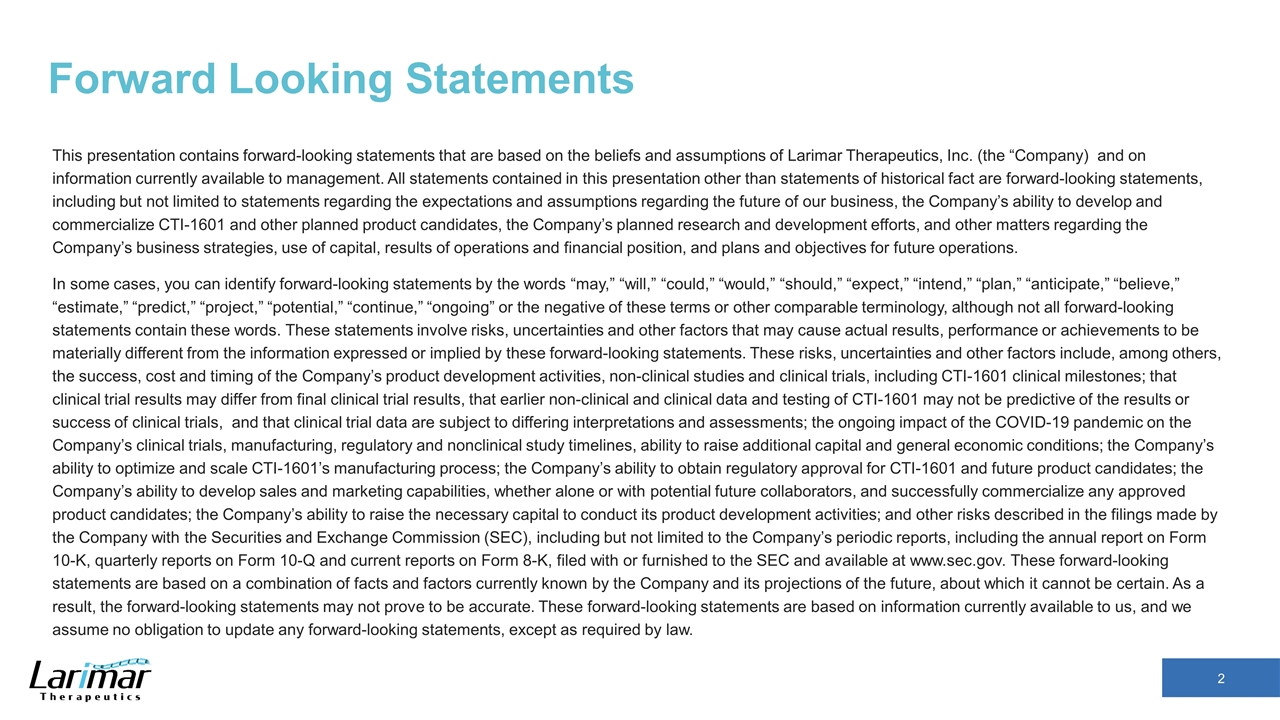
Forward Looking Statements This presentation contains forward-looking statements that are based on the beliefs and assumptions of Larimar Therapeutics, Inc. (the “Company) and on information currently available to management. All statements contained in this presentation other than statements of historical fact are forward-looking statements, including but not limited to statements regarding the expectations and assumptions regarding the future of our business, the Company’s ability to develop and commercialize CTI-1601 and other planned product candidates, the Company’s planned research and development efforts, and other matters regarding the Company’s business strategies, use of capital, results of operations and financial position, and plans and objectives for future operations. In some cases, you can identify forward-looking statements by the words “may,” “will,” “could,” “would,” “should,” “expect,” “intend,” “plan,” “anticipate,” “believe,” “estimate,” “predict,” “project,” “potential,” “continue,” “ongoing” or the negative of these terms or other comparable terminology, although not all forward-looking statements contain these words. These statements involve risks, uncertainties and other factors that may cause actual results, performance or achievements to be materially different from the information expressed or implied by these forward-looking statements. These risks, uncertainties and other factors include, among others, the success, cost and timing of the Company’s product development activities, non-clinical studies and clinical trials, including CTI-1601 clinical milestones; that clinical trial results may differ from final clinical trial results, that earlier non-clinical and clinical data and testing of CTI-1601 may not be predictive of the results or success of clinical trials, and that clinical trial data are subject to differing interpretations and assessments; the ongoing impact of the COVID-19 pandemic on the Company’s clinical trials, manufacturing, regulatory and nonclinical study timelines, ability to raise additional capital and general economic conditions; the Company’s ability to optimize and scale CTI-1601’s manufacturing process; the Company’s ability to obtain regulatory approval for CTI-1601 and future product candidates; the Company’s ability to develop sales and marketing capabilities, whether alone or with potential future collaborators, and successfully commercialize any approved product candidates; the Company’s ability to raise the necessary capital to conduct its product development activities; and other risks described in the filings made by the Company with the Securities and Exchange Commission (SEC), including but not limited to the Company’s periodic reports, including the annual report on Form 10-K, quarterly reports on Form 10-Q and current reports on Form 8-K, filed with or furnished to the SEC and available at www.sec.gov. These forward-looking statements are based on a combination of facts and factors currently known by the Company and its projections of the future, about which it cannot be certain. As a result, the forward-looking statements may not prove to be accurate. These forward-looking statements are based on information currently available to us, and we assume no obligation to update any forward-looking statements, except as required by law.
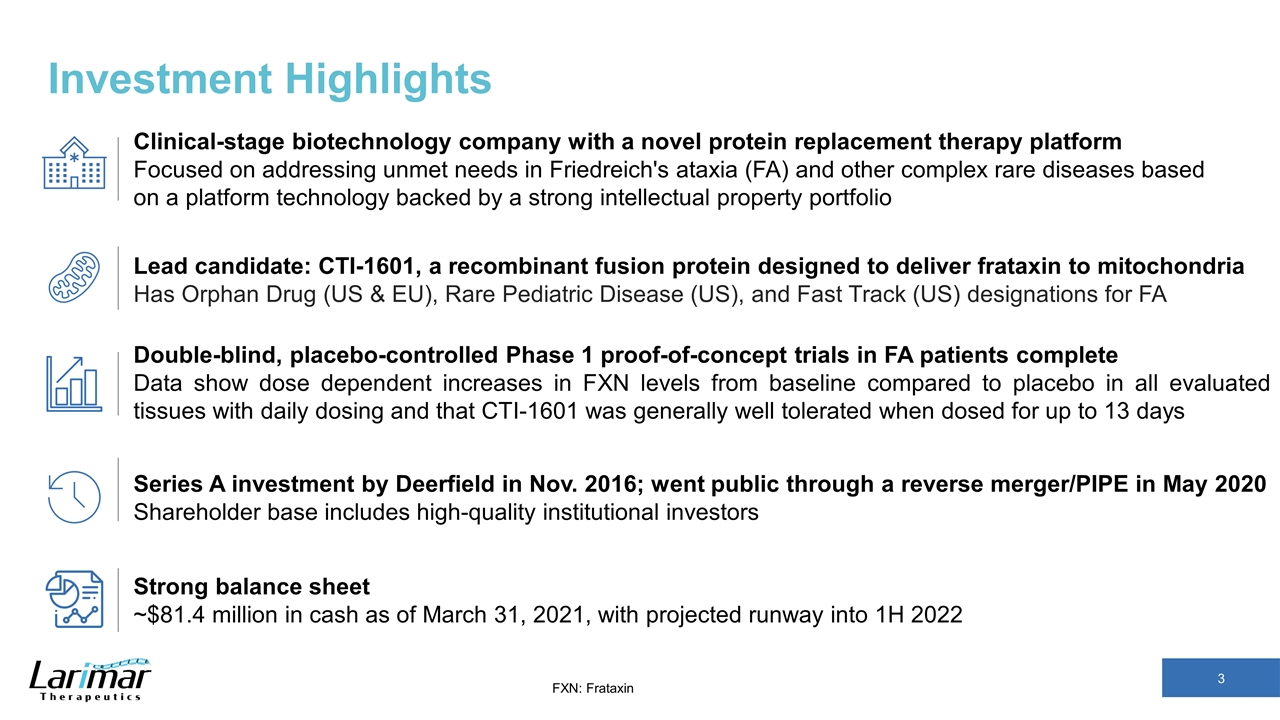
Investment Highlights Clinical-stage biotechnology company with a novel protein replacement therapy platform Focused on addressing unmet needs in Friedreich's ataxia (FA) and other complex rare diseases based on a platform technology backed by a strong intellectual property portfolio Lead candidate: CTI-1601, a recombinant fusion protein designed to deliver frataxin to mitochondria Has Orphan Drug (US & EU), Rare Pediatric Disease (US), and Fast Track (US) designations for FA Double-blind, placebo-controlled Phase 1 proof-of-concept trials in FA patients complete Data show dose dependent increases in FXN levels from baseline compared to placebo in all evaluated tissues with daily dosing and that CTI-1601 was generally well tolerated when dosed for up to 13 days Strong balance sheet ~$81.4 million in cash as of March 31, 2021, with projected runway into 1H 2022 Series A investment by Deerfield in Nov. 2016; went public through a reverse merger/PIPE in May 2020 Shareholder base includes high-quality institutional investors FXN: Frataxin
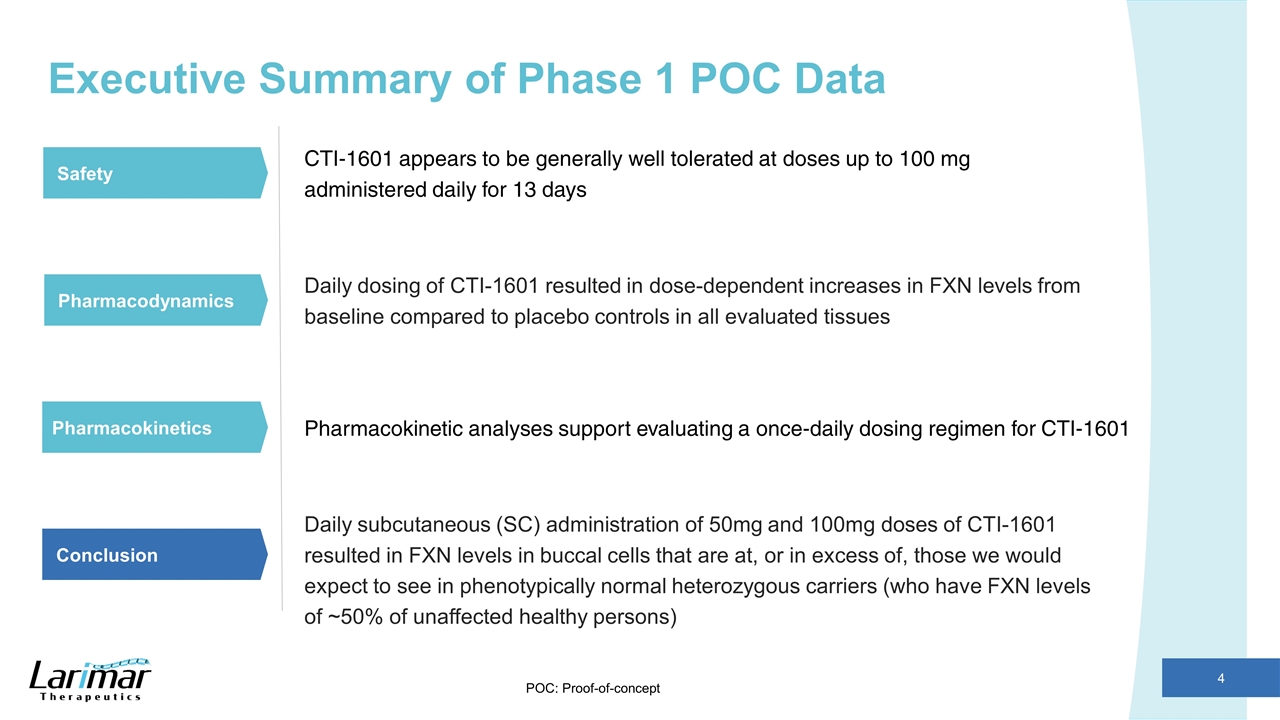
CTI-1601 appears to be generally well tolerated at doses up to 100 mg administered daily for 13 days Executive Summary of Phase 1 POC Data Daily dosing of CTI-1601 resulted in dose-dependent increases in FXN levels from baseline compared to placebo controls in all evaluated tissues Pharmacokinetic analyses support evaluating a once-daily dosing regimen for CTI-1601 Daily subcutaneous (SC) administration of 50mg and 100mg doses of CTI-1601 resulted in FXN levels in buccal cells that are at, or in excess of, those we would expect to see in phenotypically normal heterozygous carriers (who have FXN levels of ~50% of unaffected healthy persons) Pharmacodynamics Safety Pharmacokinetics Conclusion POC: Proof-of-concept
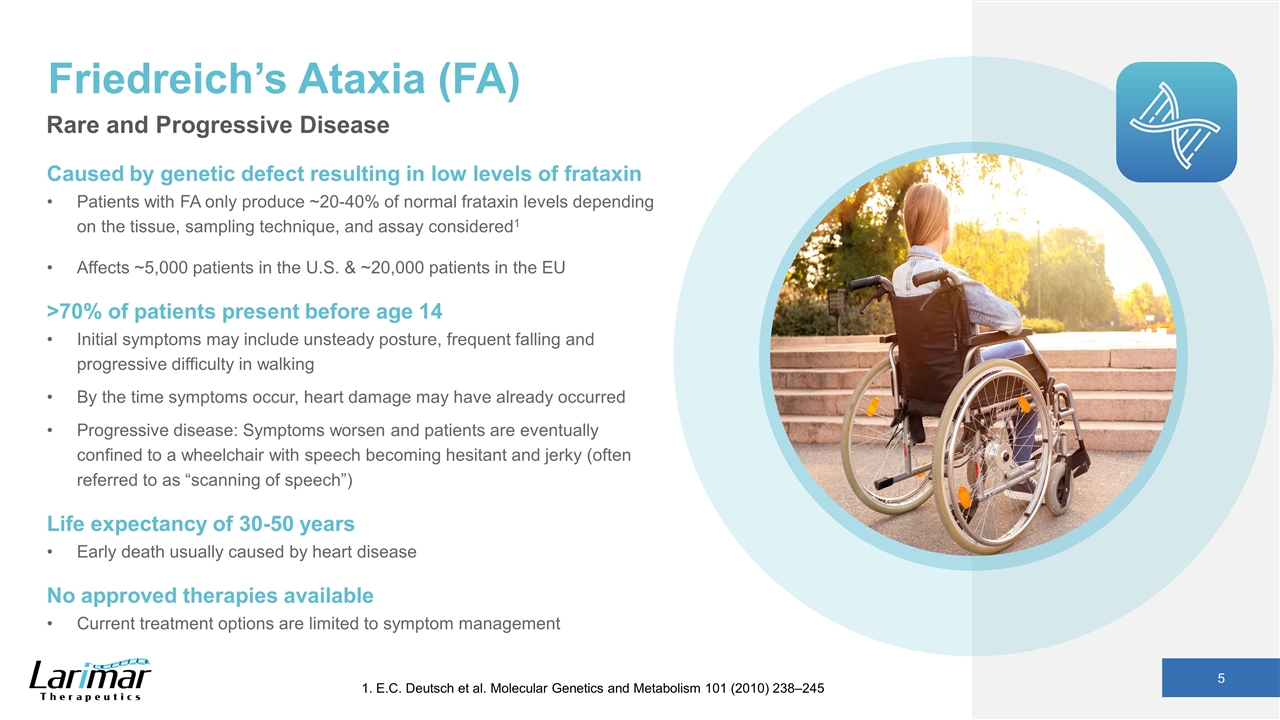
Caused by genetic defect resulting in low levels of frataxin Patients with FA only produce ~20-40% of normal frataxin levels depending on the tissue, sampling technique, and assay considered1 Affects ~5,000 patients in the U.S. & ~20,000 patients in the EU >70% of patients present before age 14 Initial symptoms may include unsteady posture, frequent falling and progressive difficulty in walking By the time symptoms occur, heart damage may have already occurred Progressive disease: Symptoms worsen and patients are eventually confined to a wheelchair with speech becoming hesitant and jerky (often referred to as “scanning of speech”) Life expectancy of 30-50 years Early death usually caused by heart disease No approved therapies available Current treatment options are limited to symptom management Friedreich’s Ataxia (FA) Rare and Progressive Disease 1. E.C. Deutsch et al. Molecular Genetics and Metabolism 101 (2010) 238–245
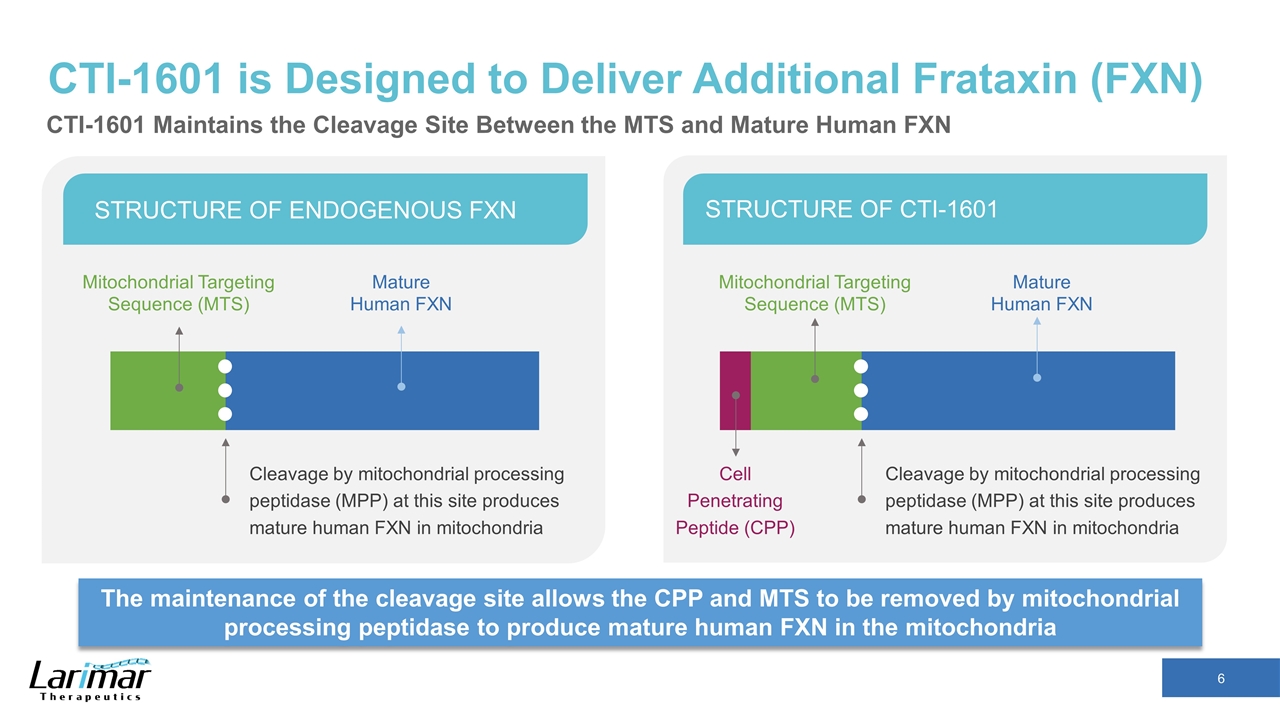
CTI-1601 is Designed to Deliver Additional Frataxin (FXN) The maintenance of the cleavage site allows the CPP and MTS to be removed by mitochondrial processing peptidase to produce mature human FXN in the mitochondria STRUCTURE OF ENDOGENOUS FXN STRUCTURE OF CTI-1601 Cleavage by mitochondrial processing peptidase (MPP) at this site produces mature human FXN in mitochondria Mitochondrial Targeting Sequence (MTS) Mature Human FXN Cleavage by mitochondrial processing peptidase (MPP) at this site produces mature human FXN in mitochondria Mature Human FXN Cell Penetrating Peptide (CPP) Mitochondrial Targeting Sequence (MTS) CTI-1601 Maintains the Cleavage Site Between the MTS and Mature Human FXN
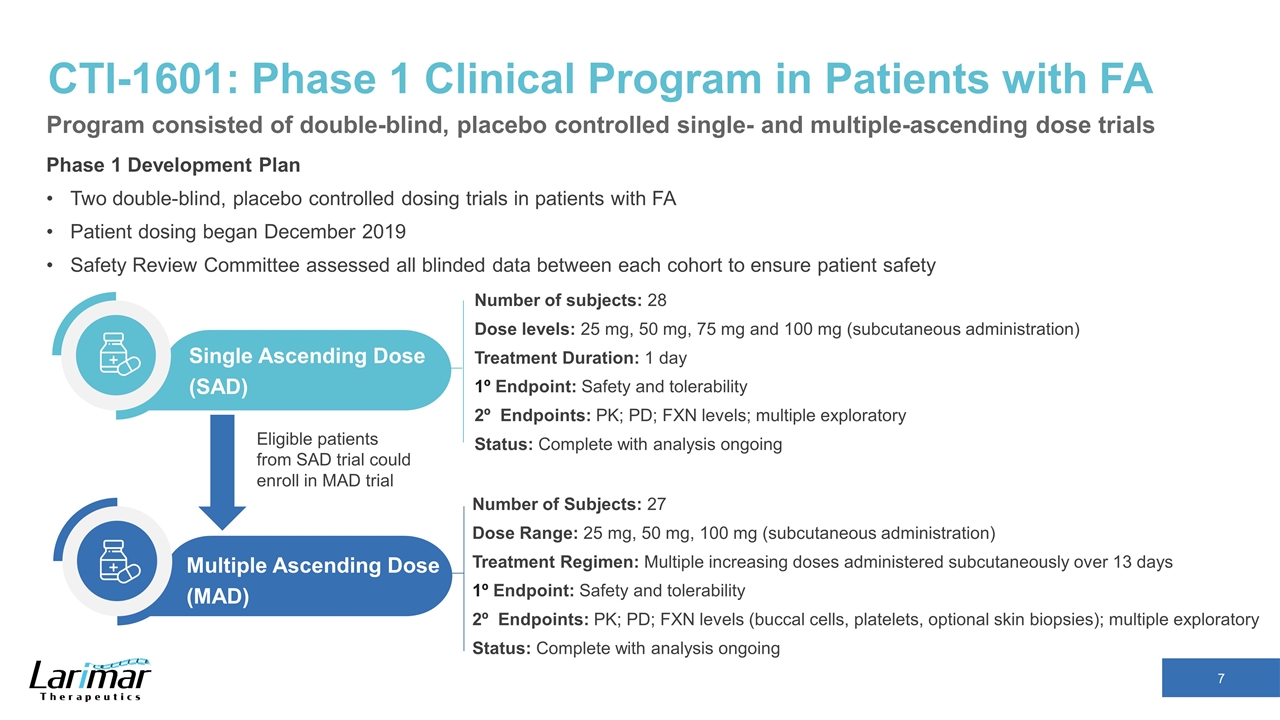
CTI-1601: Phase 1 Clinical Program in Patients with FA Phase 1 Development Plan Two double-blind, placebo controlled dosing trials in patients with FA Patient dosing began December 2019 Safety Review Committee assessed all blinded data between each cohort to ensure patient safety Number of subjects: 28 Dose levels: 25 mg, 50 mg, 75 mg and 100 mg (subcutaneous administration) Treatment Duration: 1 day 1º Endpoint: Safety and tolerability 2º Endpoints: PK; PD; FXN levels; multiple exploratory Status: Complete with analysis ongoing Single Ascending Dose (SAD) Number of Subjects: 27 Dose Range: 25 mg, 50 mg, 100 mg (subcutaneous administration) Treatment Regimen: Multiple increasing doses administered subcutaneously over 13 days 1º Endpoint: Safety and tolerability 2º Endpoints: PK; PD; FXN levels (buccal cells, platelets, optional skin biopsies); multiple exploratory Status: Complete with analysis ongoing Multiple Ascending Dose (MAD) Eligible patients from SAD trial could enroll in MAD trial Program consisted of double-blind, placebo controlled single- and multiple-ascending dose trials
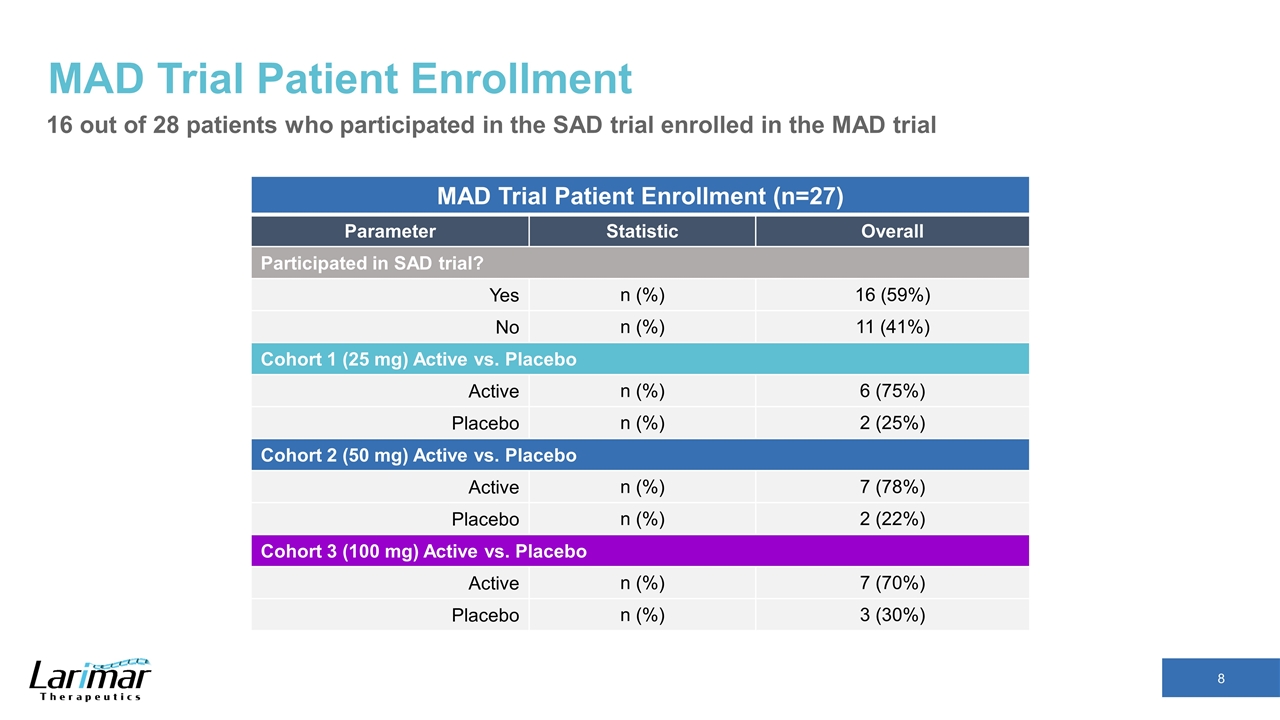
MAD Trial Patient Enrollment MAD Trial Patient Enrollment (n=27) Parameter Statistic Overall Participated in SAD trial? Yes n (%) 16 (59%) No n (%) 11 (41%) Cohort 1 (25 mg) Active vs. Placebo Active n (%) 6 (75%) Placebo n (%) 2 (25%) Cohort 2 (50 mg) Active vs. Placebo Active n (%) 7 (78%) Placebo n (%) 2 (22%) Cohort 3 (100 mg) Active vs. Placebo Active n (%) 7 (70%) Placebo n (%) 3 (30%) 16 out of 28 patients who participated in the SAD trial enrolled in the MAD trial
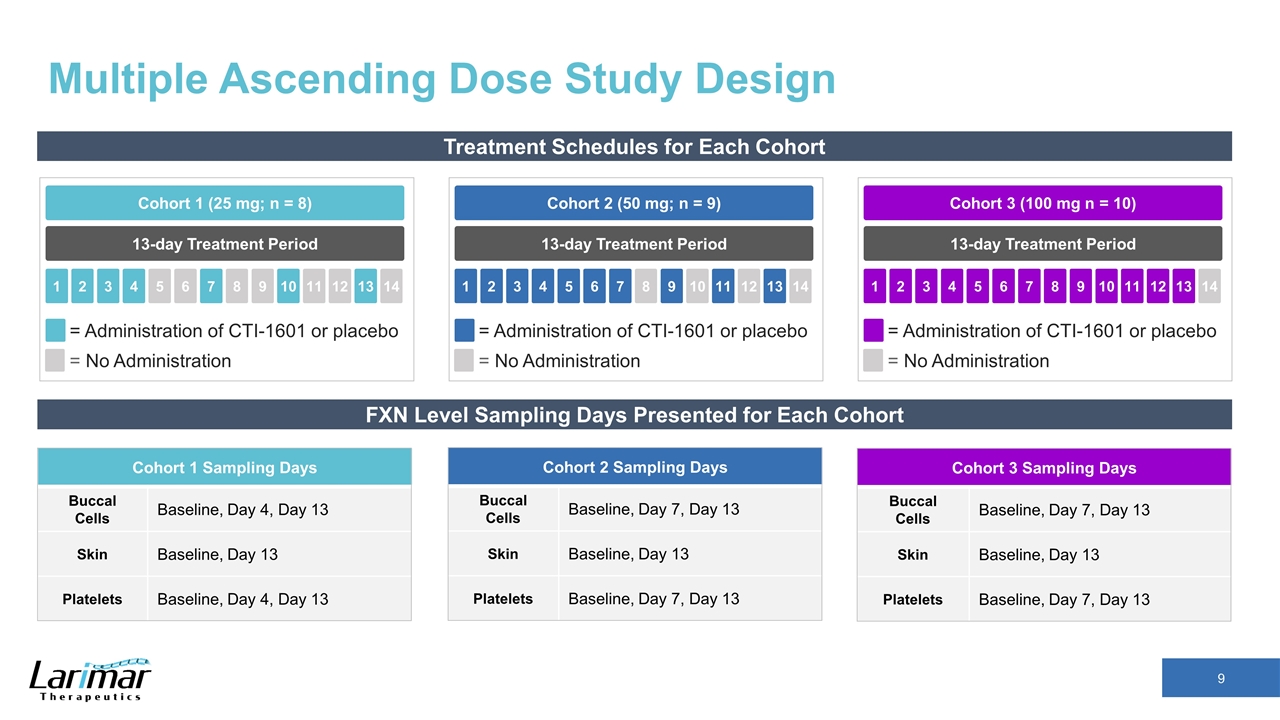
Multiple Ascending Dose Study Design Treatment Schedules for Each Cohort 13-day Treatment Period Cohort 2 (50 mg; n = 9) 2 3 4 5 1 6 7 8 9 10 11 12 13 14 = Administration of CTI-1601 or placebo = No Administration 13-day Treatment Period Cohort 1 (25 mg; n = 8) 2 3 4 5 1 6 7 8 9 10 11 12 13 14 = Administration of CTI-1601 or placebo = No Administration 13-day Treatment Period Cohort 3 (100 mg n = 10) 2 3 4 5 1 6 7 8 9 10 11 12 13 14 = Administration of CTI-1601 or placebo = No Administration FXN Level Sampling Days Presented for Each Cohort Cohort 1 Sampling Days Buccal Cells Baseline, Day 4, Day 13 Skin Baseline, Day 13 Platelets Baseline, Day 4, Day 13 Cohort 2 Sampling Days Buccal Cells Baseline, Day 7, Day 13 Skin Baseline, Day 13 Platelets Baseline, Day 7, Day 13 Cohort 3 Sampling Days Buccal Cells Baseline, Day 7, Day 13 Skin Baseline, Day 13 Platelets Baseline, Day 7, Day 13
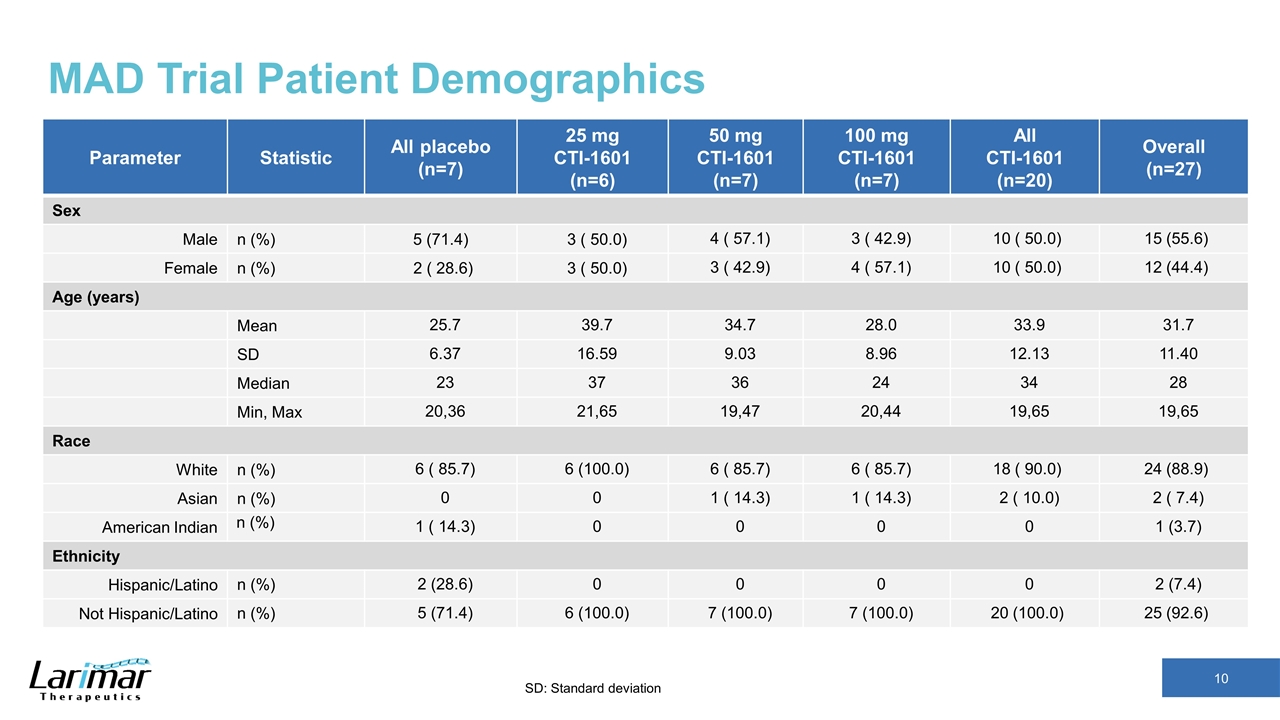
MAD Trial Patient Demographics Parameter Statistic All placebo (n=7) 25 mg CTI-1601 (n=6) 50 mg CTI-1601 (n=7) 100 mg CTI-1601 (n=7) All CTI-1601 (n=20) Overall (n=27) Sex Male n (%) 5 (71.4) 3 ( 50.0) 4 ( 57.1) 3 ( 42.9) 10 ( 50.0) 15 (55.6) Female n (%) 2 ( 28.6) 3 ( 50.0) 3 ( 42.9) 4 ( 57.1) 10 ( 50.0) 12 (44.4) Age (years) Mean 25.7 39.7 34.7 28.0 33.9 31.7 SD 6.37 16.59 9.03 8.96 12.13 11.40 Median 23 37 36 24 34 28 Min, Max 20,36 21,65 19,47 20,44 19,65 19,65 Race White n (%) 6 ( 85.7) 6 (100.0) 6 ( 85.7) 6 ( 85.7) 18 ( 90.0) 24 (88.9) Asian n (%) 0 0 1 ( 14.3) 1 ( 14.3) 2 ( 10.0) 2 ( 7.4) American Indian n (%) 1 ( 14.3) 0 0 0 0 1 (3.7) Ethnicity Hispanic/Latino n (%) 2 (28.6) 0 0 0 0 2 (7.4) Not Hispanic/Latino n (%) 5 (71.4) 6 (100.0) 7 (100.0) 7 (100.0) 20 (100.0) 25 (92.6) SD: Standard deviation
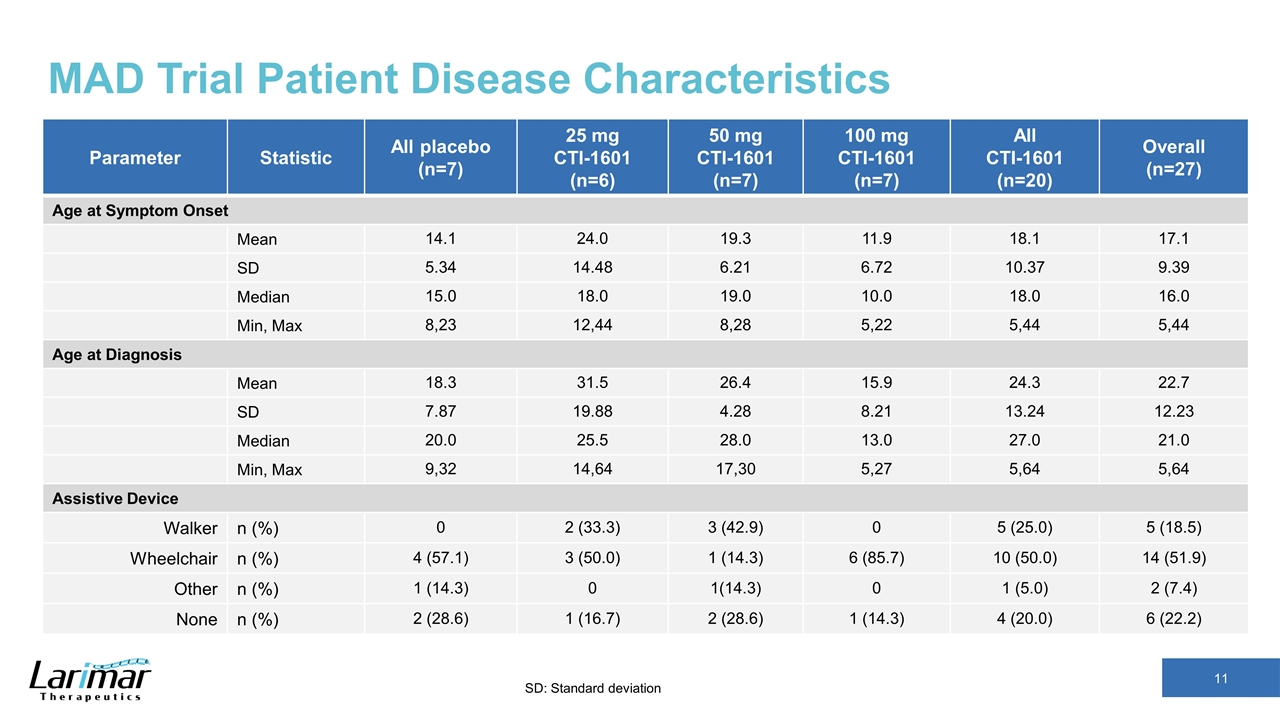
MAD Trial Patient Disease Characteristics Parameter Statistic All placebo (n=7) 25 mg CTI-1601 (n=6) 50 mg CTI-1601 (n=7) 100 mg CTI-1601 (n=7) All CTI-1601 (n=20) Overall (n=27) Age at Symptom Onset Mean 14.1 24.0 19.3 11.9 18.1 17.1 SD 5.34 14.48 6.21 6.72 10.37 9.39 Median 15.0 18.0 19.0 10.0 18.0 16.0 Min, Max 8,23 12,44 8,28 5,22 5,44 5,44 Age at Diagnosis Mean 18.3 31.5 26.4 15.9 24.3 22.7 SD 7.87 19.88 4.28 8.21 13.24 12.23 Median 20.0 25.5 28.0 13.0 27.0 21.0 Min, Max 9,32 14,64 17,30 5,27 5,64 5,64 Assistive Device Walker n (%) 0 2 (33.3) 3 (42.9) 0 5 (25.0) 5 (18.5) Wheelchair n (%) 4 (57.1) 3 (50.0) 1 (14.3) 6 (85.7) 10 (50.0) 14 (51.9) Other n (%) 1 (14.3) 0 1(14.3) 0 1 (5.0) 2 (7.4) None n (%) 2 (28.6) 1 (16.7) 2 (28.6) 1 (14.3) 4 (20.0) 6 (22.2) SD: Standard deviation
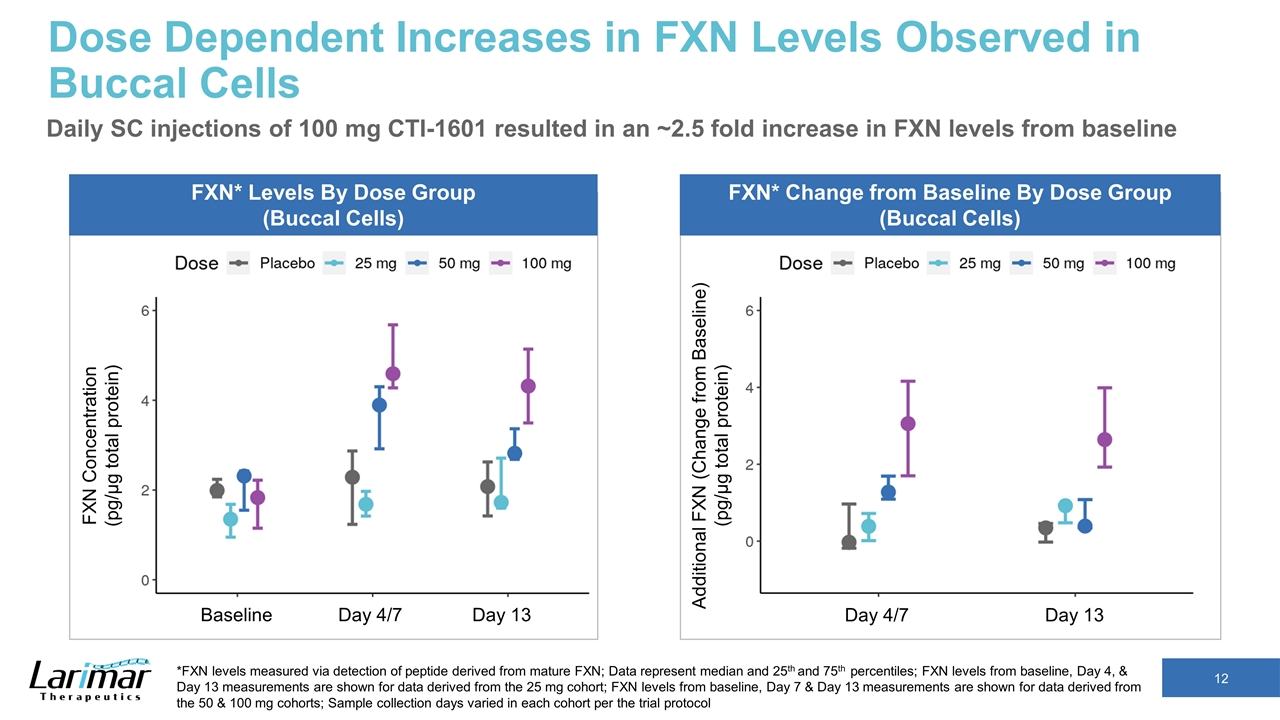
Dose Dependent Increases in FXN Levels Observed in Buccal Cells Daily SC injections of 100 mg CTI-1601 resulted in an ~2.5 fold increase in FXN levels from baseline FXN* Levels By Dose Group (Buccal Cells) FXN* Change from Baseline By Dose Group (Buccal Cells) Additional FXN (Change from Baseline) (pg/μg total protein) Day 4/7 Day 13 FXN Concentration (pg/μg total protein) Baseline Day 4/7 Day 13 *FXN levels measured via detection of peptide derived from mature FXN; Data represent median and 25th and 75th percentiles; FXN levels from baseline, Day 4, & Day 13 measurements are shown for data derived from the 25 mg cohort; FXN levels from baseline, Day 7 & Day 13 measurements are shown for data derived from the 50 & 100 mg cohorts; Sample collection days varied in each cohort per the trial protocol
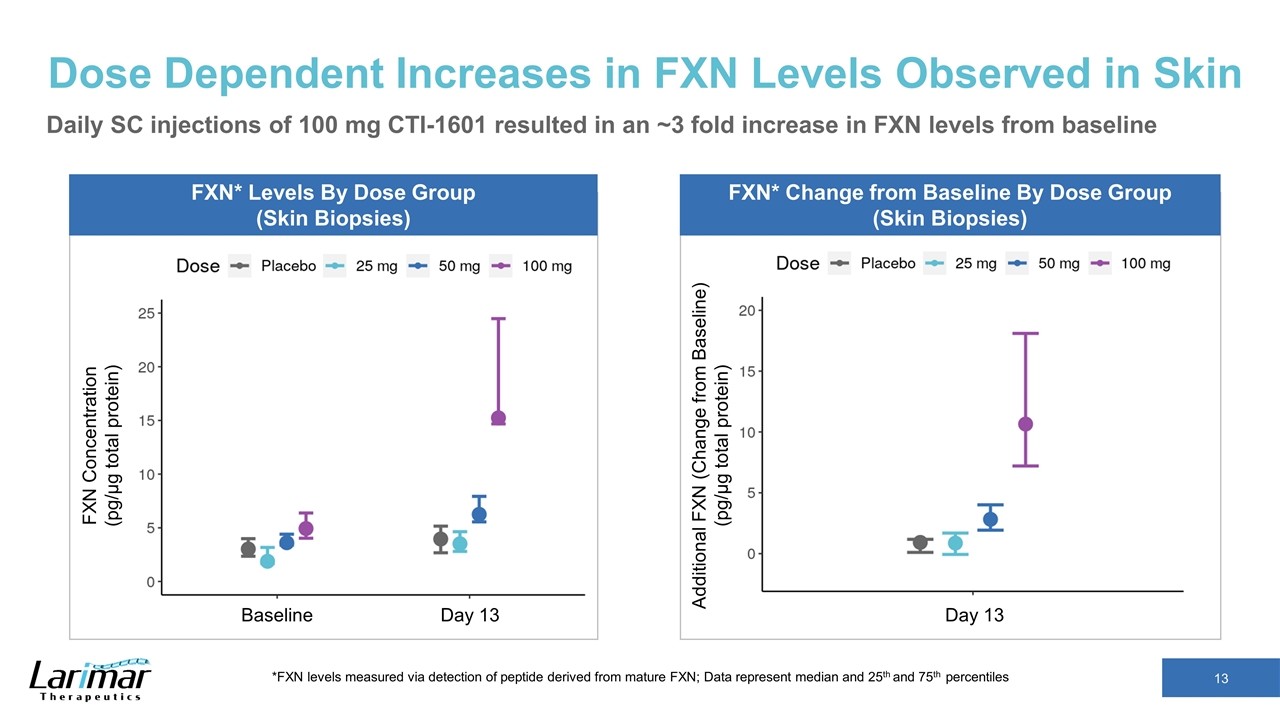
Dose Dependent Increases in FXN Levels Observed in Skin Daily SC injections of 100 mg CTI-1601 resulted in an ~3 fold increase in FXN levels from baseline FXN* Levels By Dose Group (Skin Biopsies) FXN* Change from Baseline By Dose Group (Skin Biopsies) Day 13 Baseline Day 13 *FXN levels measured via detection of peptide derived from mature FXN; Data represent median and 25th and 75th percentiles Additional FXN (Change from Baseline) (pg/μg total protein) FXN Concentration (pg/μg total protein)
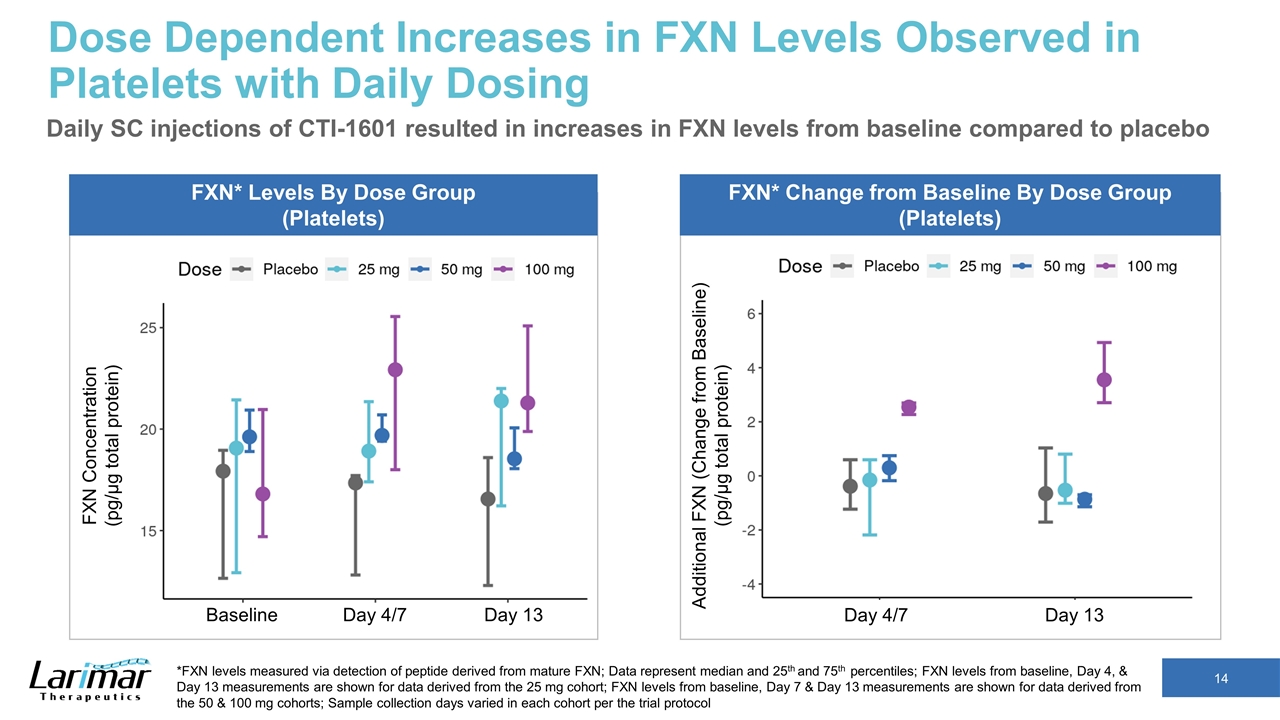
Dose Dependent Increases in FXN Levels Observed in Platelets with Daily Dosing Daily SC injections of CTI-1601 resulted in increases in FXN levels from baseline compared to placebo FXN* Levels By Dose Group (Platelets) FXN* Change from Baseline By Dose Group (Platelets) Day 4/7 Day 13 Baseline Day 13 Day 4/7 *FXN levels measured via detection of peptide derived from mature FXN; Data represent median and 25th and 75th percentiles; FXN levels from baseline, Day 4, & Day 13 measurements are shown for data derived from the 25 mg cohort; FXN levels from baseline, Day 7 & Day 13 measurements are shown for data derived from the 50 & 100 mg cohorts; Sample collection days varied in each cohort per the trial protocol Additional FXN (Change from Baseline) (pg/μg total protein) FXN Concentration (pg/μg total protein)
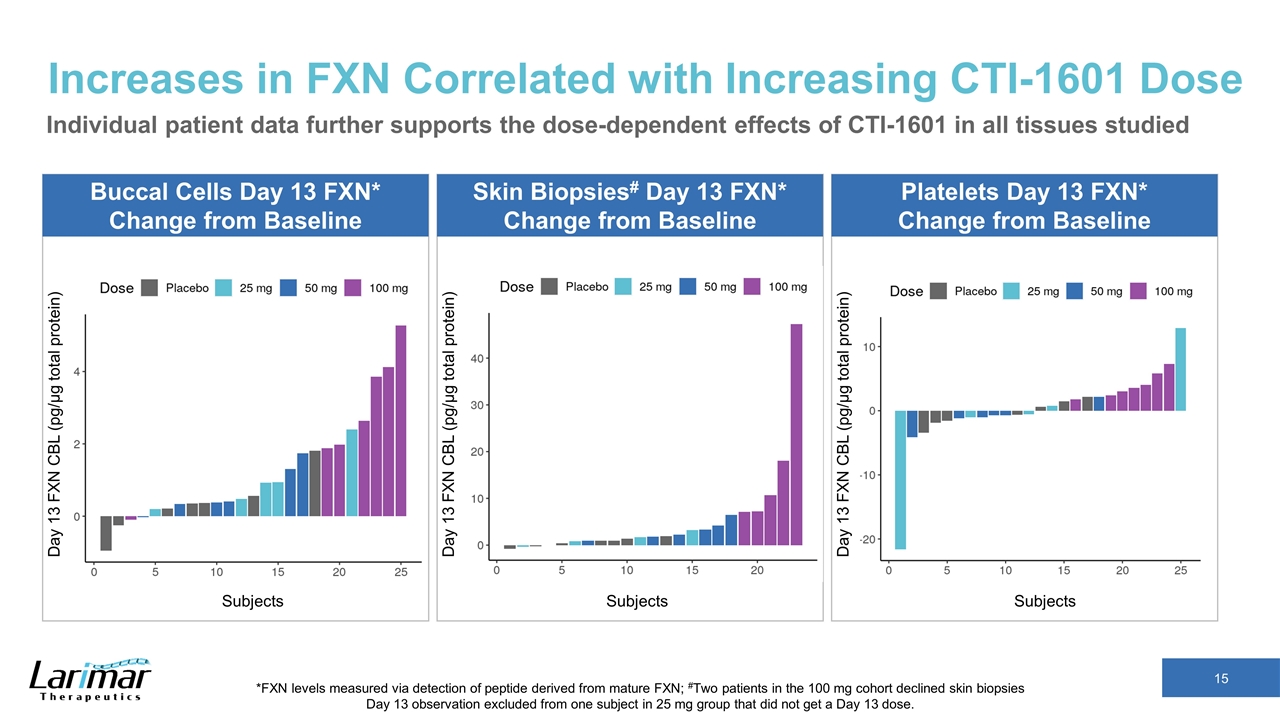
Increases in FXN Correlated with Increasing CTI-1601 Dose *FXN levels measured via detection of peptide derived from mature FXN; #Two patients in the 100 mg cohort declined skin biopsies Day 13 observation excluded from one subject in 25 mg group that did not get a Day 13 dose. Buccal Cells Day 13 FXN* Change from Baseline Skin Biopsies# Day 13 FXN* Change from Baseline Platelets Day 13 FXN* Change from Baseline Day 13 FXN CBL (pg/μg total protein) Subjects Day 13 FXN CBL (pg/μg total protein) Subjects Day 13 FXN CBL (pg/μg total protein) Subjects Individual patient data further supports the dose-dependent effects of CTI-1601 in all tissues studied
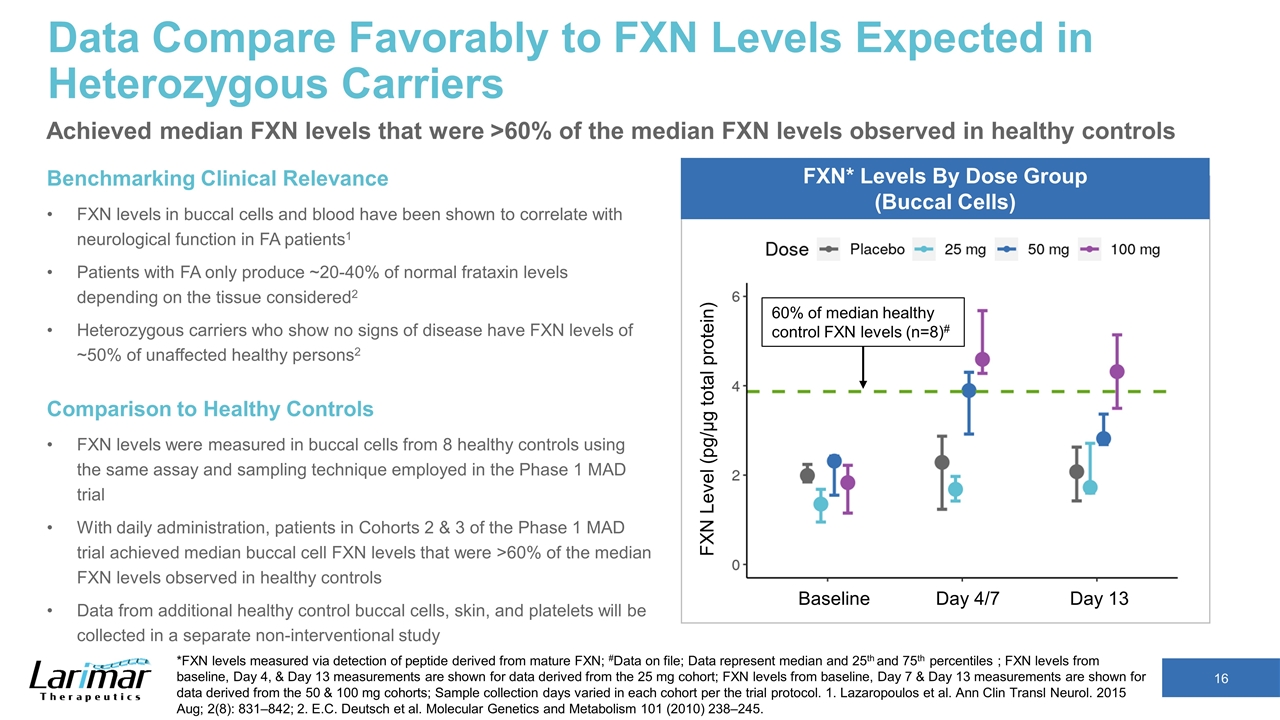
Data Compare Favorably to FXN Levels Expected in Heterozygous Carriers Achieved median FXN levels that were >60% of the median FXN levels observed in healthy controls FXN* Levels By Dose Group (Buccal Cells) FXN Level (pg/μg total protein) Baseline Day 4/7 Day 13 *FXN levels measured via detection of peptide derived from mature FXN; #Data on file; Data represent median and 25th and 75th percentiles ; FXN levels from baseline, Day 4, & Day 13 measurements are shown for data derived from the 25 mg cohort; FXN levels from baseline, Day 7 & Day 13 measurements are shown for data derived from the 50 & 100 mg cohorts; Sample collection days varied in each cohort per the trial protocol. 1. Lazaropoulos et al. Ann Clin Transl Neurol. 2015 Aug; 2(8): 831–842; 2. E.C. Deutsch et al. Molecular Genetics and Metabolism 101 (2010) 238–245. Benchmarking Clinical Relevance FXN levels in buccal cells and blood have been shown to correlate with neurological function in FA patients1 Patients with FA only produce ~20-40% of normal frataxin levels depending on the tissue considered2 Heterozygous carriers who show no signs of disease have FXN levels of ~50% of unaffected healthy persons2 Comparison to Healthy Controls FXN levels were measured in buccal cells from 8 healthy controls using the same assay and sampling technique employed in the Phase 1 MAD trial With daily administration, patients in Cohorts 2 & 3 of the Phase 1 MAD trial achieved median buccal cell FXN levels that were >60% of the median FXN levels observed in healthy controls Data from additional healthy control buccal cells, skin, and platelets will be collected in a separate non-interventional study 60% of median healthy control FXN levels (n=8)#
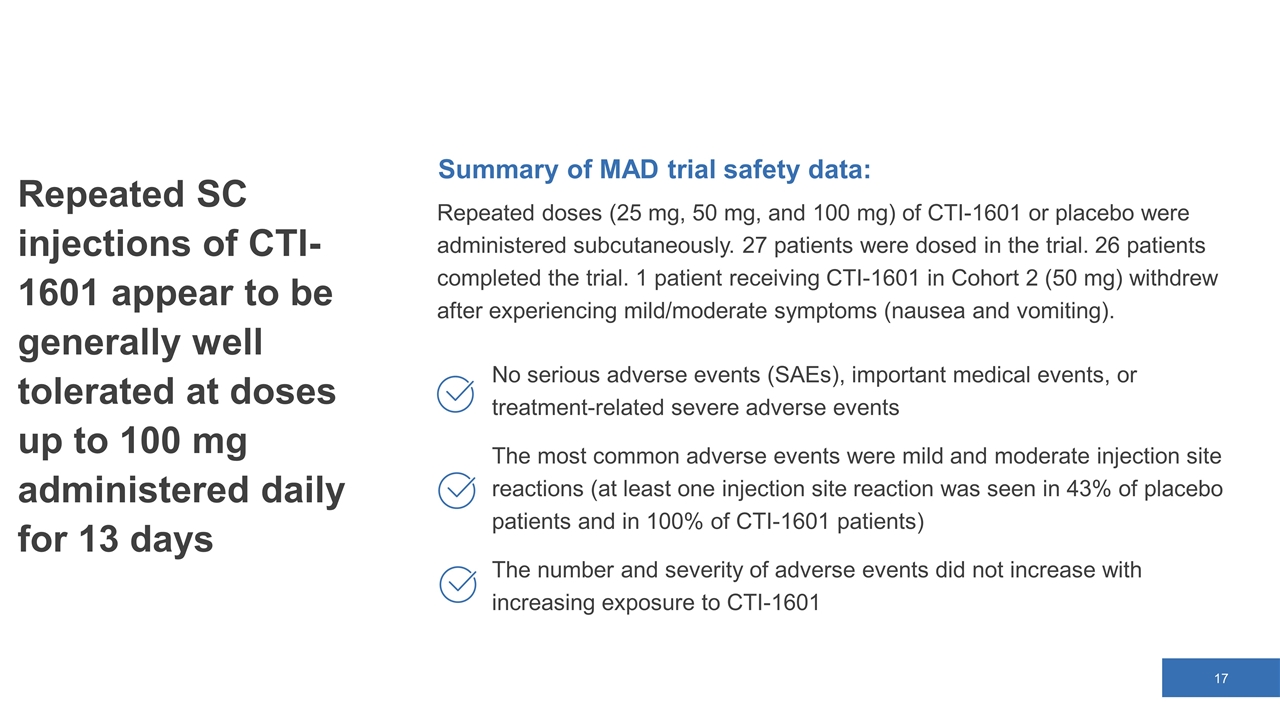
Summary of MAD trial safety data: Repeated doses (25 mg, 50 mg, and 100 mg) of CTI-1601 or placebo were administered subcutaneously. 27 patients were dosed in the trial. 26 patients completed the trial. 1 patient receiving CTI-1601 in Cohort 2 (50 mg) withdrew after experiencing mild/moderate symptoms (nausea and vomiting). No serious adverse events (SAEs), important medical events, or treatment-related severe adverse events The most common adverse events were mild and moderate injection site reactions (at least one injection site reaction was seen in 43% of placebo patients and in 100% of CTI-1601 patients) The number and severity of adverse events did not increase with increasing exposure to CTI-1601 Repeated SC injections of CTI-1601 appear to be generally well tolerated at doses up to 100 mg administered daily for 13 days
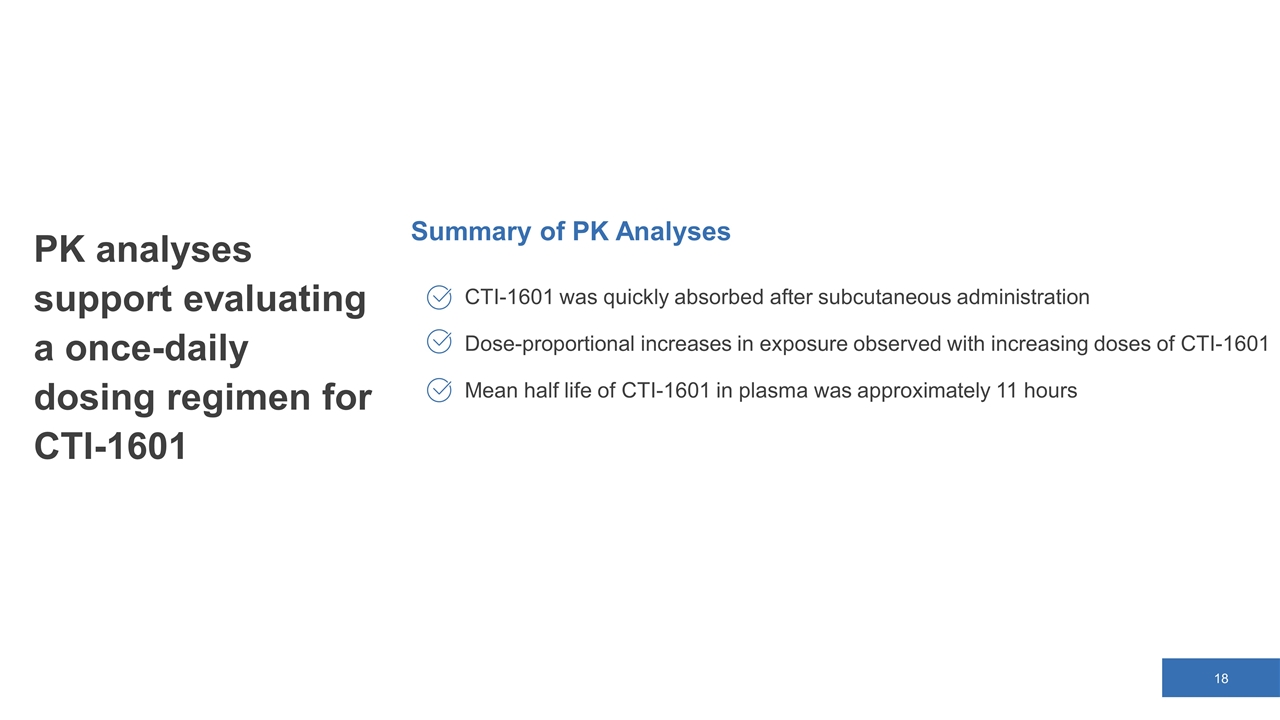
Summary of PK Analyses CTI-1601 was quickly absorbed after subcutaneous administration Dose-proportional increases in exposure observed with increasing doses of CTI-1601 Mean half life of CTI-1601 in plasma was approximately 11 hours PK analyses support evaluating a once-daily dosing regimen for CTI-1601
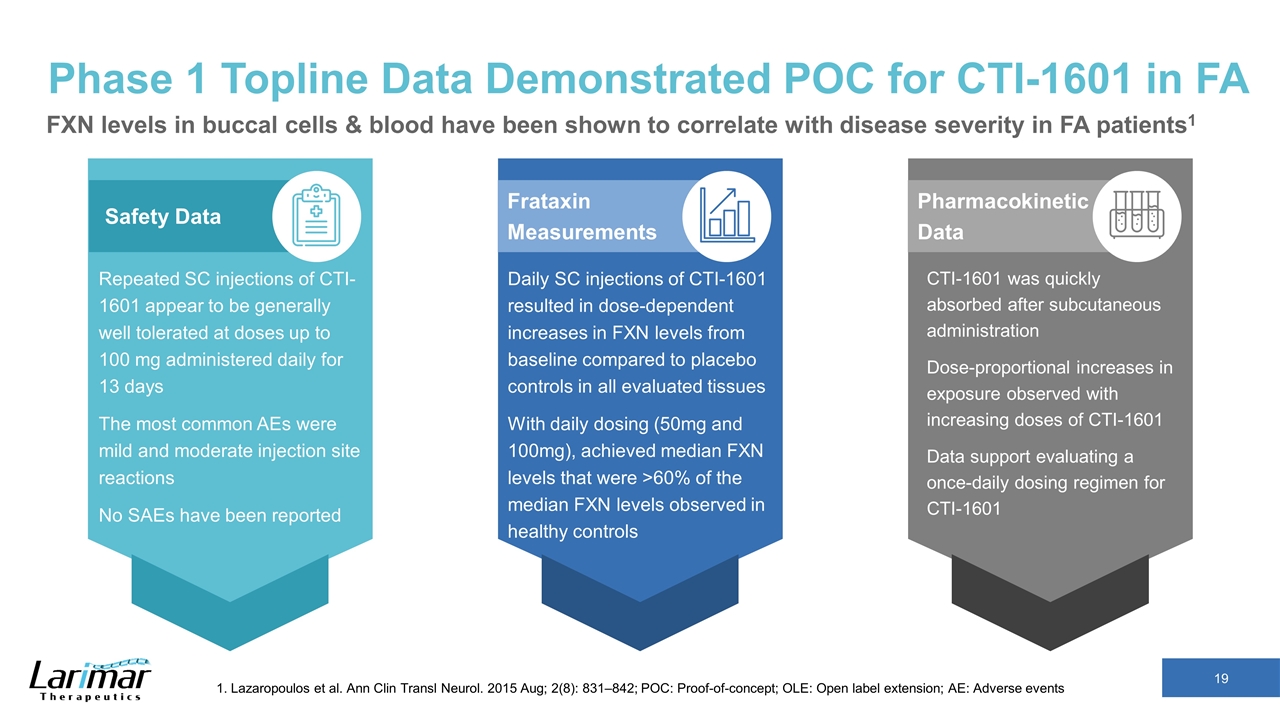
Phase 1 Topline Data Demonstrated POC for CTI-1601 in FA FXN levels in buccal cells & blood have been shown to correlate with disease severity in FA patients1 Dosing Frataxin Measurements Daily SC injections of CTI-1601 resulted in dose-dependent increases in FXN levels from baseline compared to placebo controls in all evaluated tissues With daily dosing (50mg and 100mg), achieved median FXN levels that were >60% of the median FXN levels observed in healthy controls Dosing Safety Data Repeated SC injections of CTI-1601 appear to be generally well tolerated at doses up to 100 mg administered daily for 13 days The most common AEs were mild and moderate injection site reactions No SAEs have been reported Dosing Pharmacokinetic Data CTI-1601 was quickly absorbed after subcutaneous administration Dose-proportional increases in exposure observed with increasing doses of CTI-1601 Data support evaluating a once-daily dosing regimen for CTI-1601 1. Lazaropoulos et al. Ann Clin Transl Neurol. 2015 Aug; 2(8): 831–842; POC: Proof-of-concept; OLE: Open label extension; AE: Adverse events
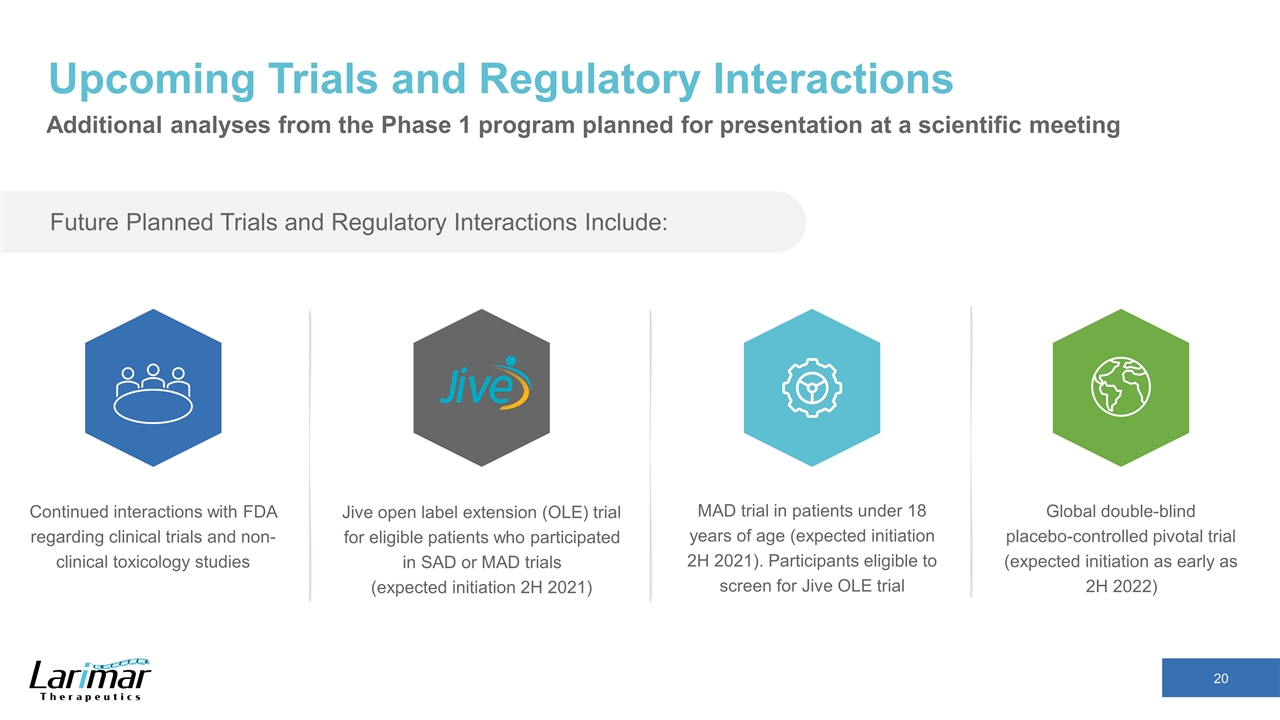
Upcoming Trials and Regulatory Interactions Future Planned Trials and Regulatory Interactions Include: Additional analyses from the Phase 1 program planned for presentation at a scientific meeting Global double-blind placebo-controlled pivotal trial (expected initiation as early as 2H 2022) Continued interactions with FDA regarding clinical trials and non-clinical toxicology studies Jive open label extension (OLE) trial for eligible patients who participated in SAD or MAD trials (expected initiation 2H 2021) MAD trial in patients under 18 years of age (expected initiation 2H 2021). Participants eligible to screen for Jive OLE trial
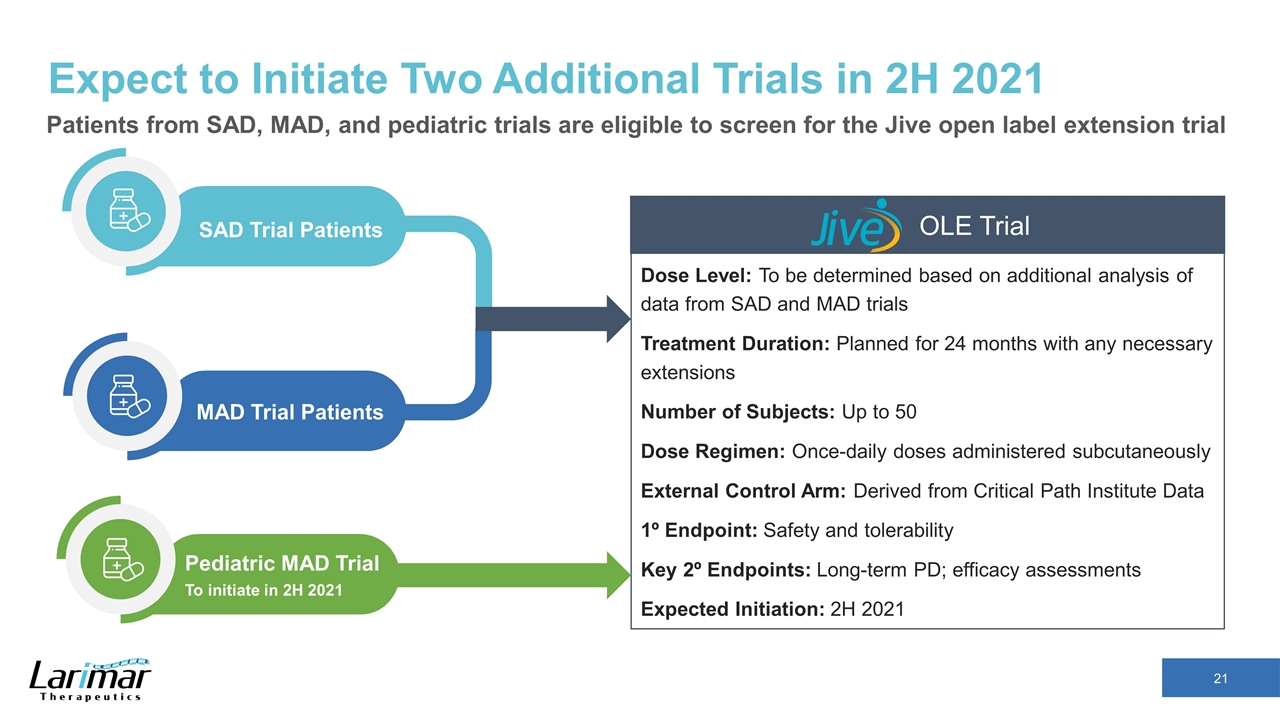
Dose Level: To be determined based on additional analysis of data from SAD and MAD trials Treatment Duration: Planned for 24 months with any necessary extensions Number of Subjects: Up to 50 Dose Regimen: Once-daily doses administered subcutaneously External Control Arm: Derived from Critical Path Institute Data 1º Endpoint: Safety and tolerability Key 2º Endpoints: Long-term PD; efficacy assessments Expected Initiation: 2H 2021 Expect to Initiate Two Additional Trials in 2H 2021 Patients eligible to enroll from Phase 1/Pediatric Patients from SAD, MAD, and pediatric trials are eligible to screen for the Jive open label extension trial SAD Trial Patients MAD Trial Patients OLE Trial Pediatric MAD Trial To initiate in 2H 2021
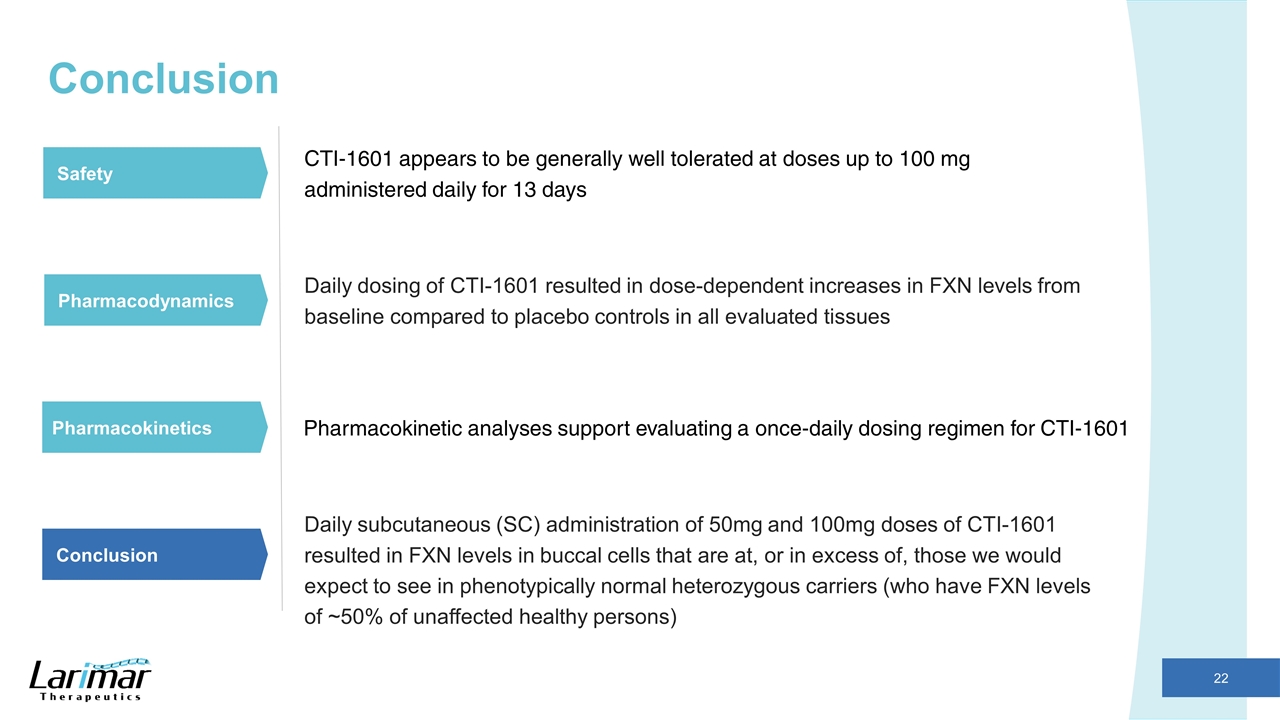
Conclusion Pharmacodynamics Safety Pharmacokinetics Conclusion Pharmacokinetic analyses support evaluating a once-daily dosing regimen for CTI-1601 Daily subcutaneous (SC) administration of 50mg and 100mg doses of CTI-1601 resulted in FXN levels in buccal cells that are at, or in excess of, those we would expect to see in phenotypically normal heterozygous carriers (who have FXN levels of ~50% of unaffected healthy persons) CTI-1601 appears to be generally well tolerated at doses up to 100 mg administered daily for 13 days Daily dosing of CTI-1601 resulted in dose-dependent increases in FXN levels from baseline compared to placebo controls in all evaluated tissues
